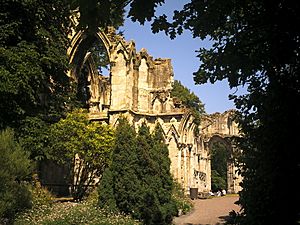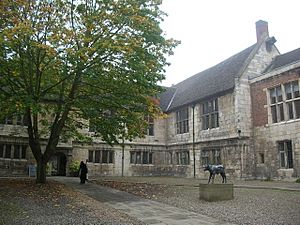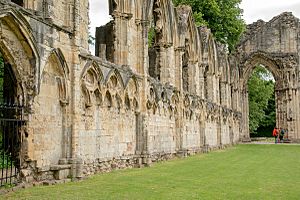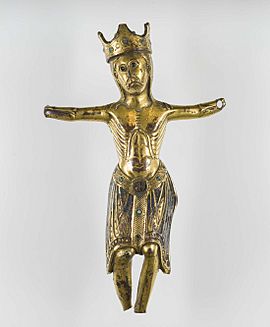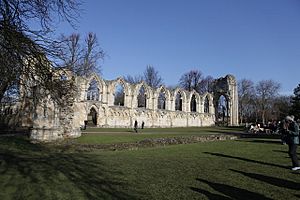St Mary's Abbey, York facts for kids
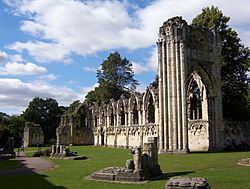
Ruins of St Mary's Abbey Church
|
|
| Monastery information | |
|---|---|
| Order | Benedictine |
| Established | 1088 |
| Disestablished | 1539 |
| Dedicated to | St. Mary |
| Diocese | York |
| People | |
| Founder(s) | Stephen of Whitby, Alan Rufus, William II of England, William the Conqueror |
| Site | |
| Location | York, Yorkshire, England |
| Coordinates | 53°57′41″N 1°05′17″W / 53.96139°N 1.08806°W |
| Visible remains | Hospitium, precinct walls, gatehouse, abbey church (ruins with part of the nave and crossing still standing), abbot's house (substantially altered); statues and other remains in the Yorkshire Museum. |
| Public access | yes (Museum Gardens) |
The Abbey of St Mary is a ruined Benedictine abbey in York, England. It is a very old and important building, listed as Grade I. Today, its remains can be found in the beautiful York Museum Gardens.
Contents
History of St. Mary's Abbey
St. Mary's Abbey was once one of the richest abbeys in Northern England. Its ruins are now located in the York Museum Gardens, west of York Minster.
Early Beginnings and Royal Support
The first church on this site was built in 1055. It was dedicated to Saint Olaf. After the Norman Conquest, a powerful Anglo-Breton lord named Alan Rufus took control of the land. He gave it to Abbot Stephen and a group of monks from Whitby Abbey.
The abbey was officially re-established in 1088. This happened when King William Rufus visited York. He gave the monks more land. The next year, in 1089, he laid the first stone for the new Norman church. The site was then dedicated to the Virgin Mary. Important people like Bishop Odo of Bayeux and Archbishop Thomas of Bayeux attended the ceremony.
The monks had moved to York from a place called Lastingham in the 1080s. Their presence in York is even mentioned in the Domesday Book, a famous survey from that time.
Challenges and Rebuilding
In 1132, there was a disagreement and a riot at the abbey. Some monks who wanted to make changes left. They went on to start a new monastery called Fountains Abbey, which followed the Cistercian order.
Just five years later, in 1137, a big fire badly damaged St. Mary's Abbey. The ruins you see today are from a major rebuilding project. This work started in 1271 and was finished by 1294.
Exploring the Abbey Grounds
The abbey had a very large area of land, called a precinct. This land was just outside the city walls, between Bootham and the River Ouse.
Abbey Walls and Gatehouse
The original boundary of the abbey had a ditch. But in the 1260s, during the time of Abbot Simon de Warwick, strong walls were built. These walls were almost three-quarters of a mile long! In 1318, the abbot got permission from the king to make the walls taller and add battlements (crenelate them). You can still see parts of this wall along Bootham and Marygate today.
The main gatehouse in Marygate and its lodge were part of a group of buildings. These connected to the older church of St Olave. Work on the gatehouse and a chapel began in 1314 and finished in 1320. However, most of the parts you see now are from the 1400s. St Mary's Tower is another structure at the corner of Marygate and Bootham.
The Abbey Church Design
The abbey church was built facing northeast-southwest. This was because of the shape of the land. The first Norman church had a rounded eastern end (an apse). Its side aisles also ended in apses, even though they looked square from the outside.
Rebuilding started in 1270 under Abbot Simon de Warwick. The abbey was very rich, so the work was finished quickly. The new church was about 350 feet (107 meters) long. It had a main area (nave) with side aisles, and north and south transepts (the arms of the cross shape) with chapels. There was also a presbytery (area around the altar) with aisles.
East of the cloister (a covered walkway) were other important buildings. These included a hallway to the chapter house, the scriptorium (where monks copied books), and the library. Further away were the kitchen, a building for new monks, and the infirmary (hospital). The abbey's own records say that Simon de Warwick, a monk, and Master Simon, a master stonemason, were in charge of the project. They were both alive when it was completed in 1294.
The Abbot's Home
The abbot's house was built in 1483 using brick. It still stands today and is known as the King's Manor. This is because it became the main office for the Council of the North in 1539. The abbots of St. Mary's and the abbey itself were even mentioned in old stories about Robin Hood. In these stories, the abbot was usually Robin Hood's enemy.
In 1513, the abbot provided four chests for the English army before the Battle of Flodden. The Abbey seemed to act as an accounting office for the army in the north.
The End of the Abbey
St. Mary's was the largest and richest Benedictine monastery in northern England. It owned a lot of land in Yorkshire. In 1539, it was worth over £2,000 a year. This was a huge amount of money back then.
The abbey was closed during the Dissolution of the Monasteries. This was when King Henry VIII closed down many monasteries in England. On November 26, 1539, the Abbey officially gave up its wealth and its 50 monks to the Crown. After this, much of the abbey was destroyed.
The Abbey Library
A list from the 1400s shows that the Abbey's library had over 750 books. Today, only about 35 of these books still exist. Only five of them were printed books. One important book is a copy of Incendium Amoris by Richard Rolle from the 15th century.
Brother Grayson's Bible
In 2010, a Latin Bible was sold at an auction in England. It was identified as belonging to Brother John Grayson from St Mary's Abbey. This small book was printed in Paris in 1526. Brother Grayson was first mentioned at the Abbey in 1528. However, he was not on the list of monks receiving pensions when the Abbey closed in 1539.
The Anonimalle Chronicle
The Anonimalle Chronicle is a very important historical record. It covers events from the legendary Brutus up to 1381. An unknown monk from St Mary's Abbey wrote it in Anglo-Norman (an old form of French) in the late 1300s.
This chronicle includes the most detailed description we have of a medieval parliament. It also has a very good account of the Peasants' Revolt. These parts were probably written by people who saw the events happen. The chronicle was later found by the Ingilby family in 1920. Today, it is kept at the Brotherton Collection at the University of Leeds.
Discoveries at the Abbey Site
The Yorkshire Museum stands on part of the abbey's cloister. Parts of the cloister walls were dug up in 1827–29 when the museum's foundations were being built. The museum and the abbey are closely linked. For example, parts of the beautifully carved chapter house vestibule (built around 1298–1307) are now part of the Tempest Anderson Hall lecture theatre. These walls and part of the warming house are still on display in the Museum's Medieval gallery.
More digging at the abbey happened in 1912. Walter Harvey-Brook, who was in charge of medieval archaeology at the museum, led these digs. He and Edwin Ridsdale Tate also designed a Museum of Medieval Architecture on the site.
Further excavations took place from 1952–56. George Willmot, the Keeper of the Yorkshire Museum at the time, found layers from before the Normans and even Roman times beneath the west wing of the nave.
In 2014 and 2015, new excavations found a rounded end (apse) in the south transept. They also found large parts of the wall foundations. Many small objects from Roman to modern times were discovered. These digs also found small pieces of human bones, which had been moved from burials on the site. A key finding was that very old archaeological remains were found very close to the surface, sometimes just 7 cm (about 3 inches) underground.
The Figurine of Jesus Christ
In 1826, a small, beautiful figurine of Christ was found at the Abbey. It was made of gilt (gold-covered) Limoges enamel in the 13th century. This figurine had somehow survived the abbey's closure in 1539. It disappeared soon after its discovery and was thought to be lost. However, it was found again in a private art collection in Germany in the 1920s. In 2019, the York Museums Trust bought the statue. It is now on display at the Yorkshire Museum.
Leaders of St. Mary's: The Abbots
The abbots of St. Mary's were very important. They were allowed to wear a special hat called a mitre. They were also regularly called to attend Parliament. In total, about 30 abbots are known to have led St. Mary's Abbey.
| Abbot | Dates of Leadership | Notes |
|---|---|---|
| Stephen of Whitby | 1088–1112 | |
| Richard | 1112–1131 | |
| Gaufried | 1131–1133 | Left the abbey |
| Severinus (or Savaricus) | - 1161 | Died while in office |
| Clement | 1161–1184 | Died while in office |
| Robert de Harpham | 1184–1195 | Removed from office |
| Robery de Longo Campo | 1197-1239 | Died while in office |
| William de Roundel | 1241-1244 | Died while in office |
| Thomas de Warthill (Wardhull) | 1244-1258 | Died while in office |
| Simon de Warwick | 1258–1296 | Died while in office |
| Benedict de Malton | 1296–1303 | Resigned from office |
| John de Gilling | 1303–1313 | Died while in office |
| Alan de Wasse | 1313–1331 | Died while in office |
| Thomas de Malton | 1331–1359 | Resigned from office |
| William de Mary's | ?1359–1382 | Died while in office |
| William de Bradford (Bridford or Brydford) | 1382–1389 | Died while in office |
| Thomas de Staynesgrave | 1389–1398 | Died while in office |
| Thomas de Pygott (Pygdt) | 1398–1405 | Died while in office |
| Thomas de Spoffoth | 8 June 1405-?1421 | Resigned from office |
| William Dalton | 1422–1423 | Died while in office |
| William Wells | 1423–1436 | Resigned from office |
| Roger Kyrkby (or Kiby) | 1437-1438 | Died while in office |
| John Cottingham | 1438-1464 | Died while in office |
| Thomas Bothe (Booth) | 1464–1485 | Resigned from office |
| William Senhouse (Sever) | 1485-1502 | Later became Bishop of Durham (1502–1505) |
| Robert Wanhope | 1502–?1507 | |
| Edmund Thornton | 1507-?1521 | |
| Edmund Whalley | 1521-1530 | |
| William Thornton | 1530–1539 | Abbot during the Dissolution of the Monasteries |
Important Burials at the Abbey
Some notable people were buried at St. Mary's Abbey, including:
- Stephen, Count of Tréguier
- Abbot Thomas Spofforth
- William de Vescy of Kildare
What Remains Today
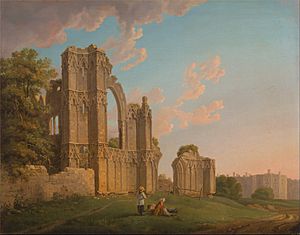
Today, only the north and west walls of the abbey remain. There are also a few other parts:
- The half-timbered Pilgrims' Hospitium (a guesthouse).
- The West Gate.
- The 14th-century timber-framed Abbot's House, now called the King's Manor.
The walls still have towers along the north and west sections. St Mary's Tower is at the northwest corner. There is also a polygonal water tower by the river. A lot of stone was taken from the site in the 1700s. For example, stone was used for St. Olave's Church in 1705. More stone was used for Beverley Minster between 1717 and 1720. In 1736, stone was even used for the Lendal Ferry landing stage.
In 1929, Edwin Ridsdale Tate described the abbey's remains. He said that York was full of charm, and the gardens of the Philosophical Society, where St. Mary's Abbey stands, were the most charming spot of all.
Images for kids
See also
 In Spanish: Abadía de Santa María (York) para niños
In Spanish: Abadía de Santa María (York) para niños


